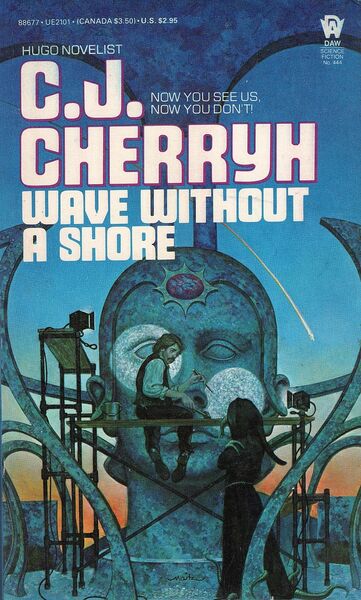The Measure of All Things
Wave Without a Shore
By C J Cherryh

6 May, 2025
C. J. Cherryh’s 1981 Wave Without a Shore is a stand-alone science fiction novel set in the Alliance-Union universe.
Sculptor Herrin Law is Freedom’s foremost artist, a creative genius without parallel on the thinly populated, backwater planet. Waden Jenks (friend) and Keye Lynn (occasional lover) might consider themselves his peers, but surely Law is superior to Jenks and Lynn.
At least, that’s how Law sees it. If there is one thing the people of Freedom are good at, it is perceiving reality the way they want it to be.
Freedom’s people do not see themselves as isolated rustics because to compare oneself with other planets, one has to admit those planets exist. Freedom’s people consider the rest of the universe as irrelevant. Anything that is irrelevant does not exist, as far as Freedom’s citizens are concerned.
The citizens apply this convenient conceptual framework to the whole of their existence. Failures — the poor, the mentally troubled — are unpleasant to consider. Therefore, one does not see them. The fact that the native Ahnit predate humans on Freedom is inconvenient. Therefore, one does not see them either. By carefully curating the reality one acknowledges, one shapes reality.
Law is as iron-willed as any other true citizen. As an artist, however, he is lamentably inclined to notice, however briefly, that which must be unseen. This is a burden with which he struggles.
Upon the death of his father, First Citizen Jenks, Waden Jenks ascends to his father’s office. Determined to impose his reality on Freedom, Jenks commissions a grand sculpture from Law. Jenks also opens negotiations with the Alliance, hoping to replace the pirates who are currently Freedom’s main source of trade goods.
Law’s sculpture is magnificent. This presents Jenks with a problem. What if at some later time, young Law surpasses himself? Jenks’ grand commission would then be but second best. The only reasonable alternative is to request that Law abandon sculpture. When Law refuses, Jenks has Law’s hands broken.
Now a pariah, Law might have perished save for an Ahnit, Sbi. Sbi has long been curious as to why the interstellar colonists behave as they do. Sbi comes to Law’s assistance. Remarkably, the desperate Law not only acknowledges Sbi, he opens a dialogue with the baffled Ahnit.
This ability to accept unacceptable reality is extremely unfashionable on Freedom. Nevertheless, it will serve Law well. Jenks’ diplomatic outreach goes poorly. As the rapidly dwindling population of citizens discover, ignoring orbital bombardment doesn’t make the bombardment go away. Therefore, new skills are needed, the very skills Law now has.
~oOo~
I do like that Don Maitz cover.
Yes, this novel is in some respects similar to China Miéville’s 2009 The City and the City. Due to the linear nature of time and the fact that 2009 postdates 1981, if there is a connection, it is from Cherryh to China Miéville.
If I were still tracking political systems, this would be counted as an autocracy. To be fair to Freedom, not only is democracy a concept that does not seem to have made it to the stars, I don’t know how you’d run elections with people whose reaction to setbacks is to deny they happened. Most likely, every candidate would insist they’d won1.
The novel never provides a number for Freedom’s human population2, but it’s suggestive that the colony’s mightiest city, fabled Kierkegaard, has ten streets people acknowledge and one that they do not3. No surprise that the planet lacks the industrial base to replace its failed space station. It’s important, therefore, to take details such as Law’s unparalleled artistic accomplishments and Jenks’ pride in his flawless genes and political acumen with a grain of salt.
This isn’t me being snarky about space-hicks. Jenks’ confident political maneuvering leaves Kierkegaard in ruins. In fact, it’s clear that Cherryh isn’t very sympathetic towards applied solipsism in general. It’s quite possible the only reason Freedom lasted as long as it did is because it was protected by its isolation.
Freedom’s inordinately fragile sophomoric philosophy can’t really support a tome. Cherryh clearly realized this, because this isn’t so much a weighty book as it is an example of why I keep insisting 21st novellas would have been considered perfectly acceptable novels forty or fifty years ago. The paperback is just 176 pages, the perfect length for the story Cherryh wants to tell.
Wave Without a Shore is available (as part of an omnibus) here (DAW), here (Barnes & Noble), and here (Chapters-Indigo).
I did not find Wave Without a Shore at Bookshop US, Bookshop UK, and Words Worth Books.
1: See, for example, the 2020 American election. USA delenda est.
2: The Ahnit population is also small, thanks to the deadly diseases the colonists brought with them. One is reminded of Old-World plagues as they affected the New World.
3: A detail I will come back to when I reach Cherryh’s 2009 Regenesis: Cherryh’s polities are surprisingly low population. Alliance in the 25th century has fewer than a million people, while Union seems to have about as many people as current day New Zealand.
